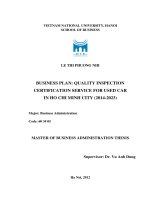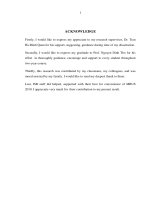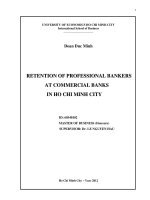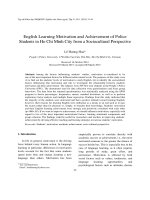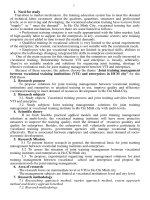FACTORS AFFECTING EMPLOYEES’ MOTIVATION IN HOTEL INDUSTRY IN HO CHI MINH CITY
Bạn đang xem bản rút gọn của tài liệu. Xem và tải ngay bản đầy đủ của tài liệu tại đây (1.16 MB, 86 trang )
1
ACKNOWLEDGE
Firstly, I would like to express my appreciate to my research supervisor, Dr. Tran
Ha Minh Quan for his support, suggesting, guidance during time of my dissertation.
Secondly, I would like to express my gratitude to Prof. Nguyen Dinh Tho for his
effort in thoroughly guidance, encourage and support to every student throughout
two-year-course.
Thirdly, this research was contributed by my classmates, my colleagues, and was
moral assisted by my family. I would like to send my deepest thank to them.
Last, ISB staff did helped, supported with their best for convenience of MBUS
2010. I appreciate very much for their contribution to my present result.
2
ABSTRACT
Within 10 years, hotel industry in Ho Chi Minh city has developed impressively and
has quite highly demanded in employing labor force. Working environment is stable
and professional is one of many attractive points of hotels, but it contains many
characteristics which may demotivate employees. Motivating staff to work better,
more efficient is always one of business goals, especially in this special industry.
This study aims to investigate which factor affecting to hotel employee’s
motivation. The result showed that recognition, development, supervisor and
promotion are four factors which affecting to hotel employee’s motivation in Ho
Chi Minh city context.
Keywords: employee motivation, hotel industry, recognition, Ho Chi Minh city
3
Contents
ACKNOWLEDGE 1
ABSTRACT 2
Contents 3
List Of Tables 5
List of Figures 6
List of Exhibits 7
CHAPTER 1. INTRODUCTION 8
1.1 Research background 8
1.2. Research questions 9
1.3. Research objectives 9
1.3. Scope of this study 10
1.4. Research contribution 10
1.5. Research structure 10
CHAPTER 2. LITERATURE REVIEW 12
2.1. Definition of Motivation 12
2.2 Motivation theories 12
2.3. Previous researches about motivation in hospitality industry and identifying
hypotheses in this study. 18
2.4. Research model 24
4
CHAPTER 3. RESEARCH METHOD 26
3.1 Research process 26
3.2 Measurement scale 26
3.3 The qualitative pilot research 26
3.4. Main research 29
CHAPTER 4. DATA ANALYSIS 31
4.1 Descriptive statistics of sample 31
4.2 The construct measurement scale 32
4.2.1. Cronbach’s Alpha results of each measurement 33
4.2.2. Exploratory Factor Analysis 35
4.3.Adjustment of hypotheses and research model 38
4.4. Regression analysis 39
4.5. Verification the different level of motivation in personal characteristics 43
4.6. Discussion about findings 44
CHAPTER 5. CONSLUSIONS AND RECOMMENDATIONS 46
5.1. Recommendations 46
5.2. Limitations and recommendation for future researches 50
REFERENCES 52
APPENDIX 57
5
List Of Tables
Table 2.1. A Reorganization of Maslow's and Alderfer's Hierarchies 59
Table 2.2. Summary of factors affecting to employees’ motivation in hotel
industry 19
Table 3.1. Scales of Management 26
Table 3.2. Scale of Working conditions 27
Table 3.3. Scale of Recognition 27
Table 3.4. Scale of Development 28
Table 3.5. Scale of Motivation 28
Table 4.1. Demographic Statistics of the Respondents 32
Table 4.2. Cronbach’s Alpha results of each measurement 33
Table 4.3. KMO and Bartlett’s test for independent variables 35
Table 4.4. KMO and Bartlett’s test for dependent variables 38
Table 4.5. Pearson Correlation Coefficient 39
Table 4.6 Summary output of Regression Analysis 40
Table 4.7. Summary output of Regression Analysis after remove one factor 41
Table 4.8 Personal characteristics and employee’s motivation 43
Table 4.9. Hypotheses testing 45
6
List of Figures
Figure 2.1 Research model 25
Figure 3.1 Research process 26
Figure 4.1. Adjusted research model 38
7
List of Exhibits
Exhibit 2.1. Maslow’s Hierarchy of Needs 57
Exhibit 2.2. The Herzberg's motivation-hygiene theory 57
Exhibit 2.3. Equity theory ratios 58
Exhibit 2.4. Expectancy Model 59
Exhibit 2.5. A diagram of Theory X and Theory Y 59
Exhibit 2.6. Job Charactersitics Model 60
8
CHAPTER 1. INTRODUCTION
1.1 Research background
Tourism industry plays a significant role in Vietnamese economic structure.
According to Grant Thornton Vietnam, in 2012 tourism market has welcomed more
than six million foreign travellers, which increases 19.1% compared with last year
data. That result has contributed to general development of hotel industry. This field
had been attracting nearly 11 billion USD with 247 projects up to 2009; ranked the
3
rd
after industrial processing, manufacturing and real estate. The more development
in hotel industry, the more demand of labor force in this field. But hotel industry is
a kind of service industry, whose products created from human’s contact, owned
unique characteristics. Seasonableness is a stand out characteristic, which influences
to labor force in this field. In the peak period, hotels need a large amount of labor
force, working with high productivity. But in low season, they keep a few
permanent employees. The consequence is an unstable labor force, demotivated
part-time employees and negative influence to performance of permanent staff.
Customer target in hotel is tourists, who come from different countries, which
owned different cultures, hobbits, customs, etc. Servers, who directly contact with
customers, need to understand their requirements in order to assure quality service.
The consequence is the stressful job toward servers. In addition, employees in hotel
are required to work in high specialization, under high pressure of discipline,
together with sensibility, accuracy and consistency.
For those above characteristics, labor force in hotel is likely to leave when they are
under high pressure and demotivated from management team. High staff turnover is
a common and costly problem in hotel industry. Reasons include such as low pay,
antisocial working hours, menial work and limited career opportunities (Xander Lub
et al 2012, cited in Barron, 2008; Davidson et al., 2011; Kusluvan and Kusluvan,
2000; Walsh and Taylor, 2007). An organization will be forced to invest million
dollars in recruiting, orientating, training, etc. if they own an unstable workforce.
9
Without continuity in customer relationship, organization does not have customer
loyalty, stressful management, conflict happens easily and low efficiency. Those
make difficult for company to compete on marketplace. Hence, constructing a good
policy to motivate and retain good performance employees, who can create unique
experiences and relationships with customers, is an important mission. A stable
workforce is a significant competitive advantage. “Customer relationships are
stronger when an organization’s workforce is stable and customers can depend on
the company people – the continuity of their product knowledge, industry
experience and proven performance.” (Kreisman, 2002).
There have many researches, conducted in many countries, found out factors
affecting to employees’ motivation in hotel industry in general. With a speed-up in
developing hotels, needs of recruiting new employees and retain good performance
ones, studying about motivation in hotel in Vietnam is necessary in order to
improve competitive advantage in market. This study raises research objectives
about creating motivation in hotel industry.
1.2. Research questions
1.What factors affecting to employees’ motivation in hotel industry in Ho Chi Minh
City?
2. How does each factor affect to employee’s motivation?
1.3. Research objectives
The goal of this research are as below
- To determine factors affecting employees’ motivation in hotel industry in Ho
Chi Minh city.
- To evaluate how each factor affects to working motivation.
- To determine the impact of personal characteristics such as: gender, age,
education level, experience, contract type and hotel standards to employee
motivation.
10
1.3. Scope of this study
This research will be conducted in hotel businesses in Ho Chi Minh City, included 4
or 5-star hotels and other under 4-star hotels. The interviewees will be employees
who working in variety departments such as: food and beverage, front office,
finance, human resource, etc.
1.4. Research contribution
This research has contributed to measurement system of working motivation level
in hotel industry. In reality, this research will help Managers who working in hotel
industry in decision making in human resource management, creating appropriate
decisions in managing, in order to increase productivities and employees’
motivation level. Otherwise, the result of this research has contributed to human
resources management researches in overall and in hotel industry.
1.5. Research structure
This study includes four chapters after chapter 1 Introduction, as below:
Chapter 2 – Literature review : this chapter includes Definition of motivation,
theories of motivation, previous researches in hospitality industry and identifying
significant motivational factors in this paper
Chapter 3 – Research method: this chapter consists research process, measurement
scale, the pilot test and the main research which was conducted.
Chapter 4 – Data analysis: this chapter describes how each measurement scale was
evaluated and the result of testing hypothesis. It consists of sample description,
measurement scale data analysis, regression analysis and evaluating the impact of
personal characteristic on employee motivation.
Chapter 5 – Conclusion and Recommendation: this chapter presents brief
description about research findings and some of implications has mentioned. At the
11
end, research limitation and recommendations for future research have presented as
well.
12
CHAPTER 2. LITERATURE REVIEW
The literature review consists of Definition of motivation, Theories of motivation;
Previous researches in hospitality industry and identifying significant motivational
factors in this paper.
2.1. Definition of Motivation
Motivation is defined as “a process that starts with a physiological deficiency or
need that activates a behavior or a drive that is aimed at a goal incentive” (Luthans,
1998). According to Spector (2003), motivation is “an internal state that induces a
person to engage in particular behaviors”. Pinder (1998) describes work motivation
as the set of internal and external forces that initiate work-related behavior, and
determine its form, direction, intensity, and duration. The definition recognizes the
influence of both environment forces (e.g. organizational reward systems, the nature
of the work being performed) and forces inherent in the person (e.g. individual
needs and motives) on work-related behavior.
In generally, most of definitions of motivation are related to unsatisfied needs of
employees, under influences of intrinsic and extrinsic factors, forces employees to
engage to a particular behavior in order to reach their goals and satisfy their needs.
The psychology of motivation is tremendously complex (Herzberg, 1987). Theories
about motivation were developed and became popularly in practice as below.
2.2 Motivation theories
2.2.1 Maslow’s Hierarchy of Needs
Maslow’s hierarchy of Needs is a theory in psychology, proposed by Abraham
Maslow in his 1943 paper “A theory of Human Motivation”. Maslow believed that
at least five sets of goals which can be referred to as basic needs: physiological,
safety, love, esteem and self-actualization (Exhibit 2.1). The implication from this
13
theory is useful for managers and organization leaders. For example, there has a
advice for managers is finding ways of motivating employees by devising programs
or practices aimed at satisfying emerging or unmet needs. Another way is
implementing support programs and focus groups to help employees deal with
stress, especially during more challenging time.
2.2.2. McClelland’s Need Theory
In the publication “The Achieving Society” in 1961, McClelland described the
theory of needs focusing on three needs: achievement, power and affiliation. The
need for achievement was defined as the drive to excel, to achieve in relation to a
set of standards, to strive to succeed. The need of power was defined as the need to
make others behave in a way that they would not have behaved otherwise. The need
for affiliation was defined as the desire for friendly and close interpersonal
relationships. McClelland proposed that high achievers are more likely to be
successful entrepreneurs. The need of affiliation suggested that people have the
desire to spend time in social relationships, join group, and wanting to be loved. The
need of power reflects an individual’s desire to influence, coach, teach, or
encourage others to achieve.
2.2.3. Herzberg’s two-factor theory
The Two-factor theory (also known as Herzberg's motivation-hygiene
theory and Dual-Factor Theory) states that there are certain factors in
the workplace that cause job satisfaction, while a separate set of factors cause
dissatisfaction. It was developed by Frederick Herzberg, a psychologist, who
theorized that job satisfaction and job dissatisfaction act independently of each other
(Herzberg, 1959). Two-factor theory distinguishes between:
- Motivators (satisfaction): five factors stood out as strong determiners of job
satisfaction:
Achievement
14
Recognition
Work itself
Responsibility
Advancement
- Hygiene factors (dissatisfaction): the determinants of job dissatisfaction were
found to be:
Company policy
Administrative policies
Supervision
Salary
Interpersonal relations
Working conditions
According to Herzberg, the factors leading to Job Satisfaction are separate and
distinct from those that lead to Job Dissatisfaction. Conditions surrounding the job
such as quality of supervision, pay, company policies, physical working conditions
relations with other and job security were characterized by Herzberg as hygiene
factors, when adapted, people will not be dissatisfied; neither will they be satisfied.
If organization wants to motivate people on their jobs, Herzberg suggested
emphasizing factors associated with work itself or to outcomes directly derived
from it, such as promotional opportunities, personal growth, recognition,
responsibility and achievement. These are the characteristics that people find
intrinsically rewarding. (Exhibit 2.2.)
2.2 4. Alderfer’s ERG theory
Clayton Alderfer reworked Maslow’s Need Hierarchy to align it more closely with
empirical research. Alderfer’s theory is aslo called ERG theory – Existence,
Relatedness and Growth
15
Existence refers to our concern with basic material existence requirements; what
Maslow called physiological and safety needs.
Relatedness refers to the desire we have for maintaining interpersonal relationships;
similar to Maslow’s social/love need, and the external component of his esteem
need.
Growth refers to an intrinsic desire for personal development; the intrinsic
component of Maslow’s esteem need, and self-actualization.
Alderfer’s ERG theory differs from Maslow’s Need Hierarchy as ERG theory
demonstrates that more than one need may be operative at the same time. ERG
theory does not assume a rigid hierarchy where a lower need must be substantially
satisfied before one can move on. (Table 2.1)
2.2.5. Equity theory
The equity theory of motivation assumes that individual is strongly motivated to
maintain a balance between what they perceive as their inputs and their rewards
(Exhibit 2.3). Adams (1965) suggested that individual expectations about equity or
fair correlation between inputs and outputs are learned during the process of
socialization and through the comparison with inputs and outcomes of others. The
consequence of employee who perceiving they are not being treated fairly, create a
variety of options for the employees (Champagne, 1989). The options include
reducing their inputs through directly restricting work outputs, or increasing their
outputs in order to seeking salary increases or seeking a more enjoyable task. The
employee could withdraw from the situation, quit the job and seek another
employer.
2.2.6. Expectancy theory
Expectancy Theory proposes that a person will decide to behave or act in a certain
way because they are motivated to select a specific behavior over other behaviors
16
due to what they expect the result of that selected behavior will be (Oliver,
R.,1974). Victor H. Vroom (1964) defines motivation as a process governing
choices among alternative forms of voluntary activities, a process controlled by the
individual (Exhibit 2.4). The individual makes choices based on estimates of how
well the expected results of a given behavior are going to match up with or
eventually lead to the desired results. There are three mental components that are
seen as instigating and directing behavior: Valence, Instrumentality and
Expectancy.
2.2.7 Theory X and theory Y
Theory X and Theory Y are theories of human motivation created and developed by
Douglas McGregor in the 1960s. They describe two contrasting models of
workforce motivation.
- Theory X workers could be described as follows:
Individuals who dislike working and avoid it where possible.
Individuals, who lack ambition, dislike responsibility and prefer to be led.
Individuals who desire security.
The management implications for theory X workers were that, to achieve
organizational objectives, a business would need to impose a management system
of coercion, control and punishment.
- Theory Y workers were characterized by McGregor as:
Consider effort at work as just like rest or play.
Ordinary people who do not dislike work. Depending on the working
conditions, work could be considered a source of satisfaction or punishment.
Individuals who seek responsibility.
The management implications for theory X workers are that, to achieve
organizational objectives, rewards of varying kinds are likely to be the most popular
17
motivator. The challenge for management with theory Y workers is to create a
working environment (or culture) where workers can show and develop their ability
(Exhibit 2.5).
2.2.8.Goal setting theory
Edwin Locke (1968) stated that employees were motivated by clear goals and
appropriate feedback. In 1990, Locke and Gary Latham, who studied the effect of
goal setting in the workplace, published their seminal work, “A theory of Goal
Setting and Task Performance”. To motivate, goals must have five principles as
below:
- Clarity
- Challenge
- Commitment
- Feedback
- Task complexity
Five characteristics of Goal Setting theory is illustrated through SMART acronym,
which is applied widely in most of organizations. The Clarify of the goal is ensured
by making it Specific, Measureable and Time-bound. The Challenge associates with
Relevant, but must be Achievable firstly. The Commitment to the goal can be set
with A – Agreed and R – Realistic, instead of Achievable and Relevant. Agree
goals lead to commitment. The Feedback can be provided through Measurable.
2.2.9 Job Characteristics Model
The Job Characteristics Model (JCM) (Exhibit 2.6), as designed by Hackman and
Oldham attempts to use job design to improve employee motivation. the JSM
proposes relationships between three classes of variables:
Core job dimensions
Critical psychological states
18
Affective outcomes
They have identified that any job can be described in terms of below key job
characteristics:
- Skill Variety: a degree to which a job requires different skills and talents to
complete a number of different activities.
- Task Indentify: the dimension refers to the completion of a whole and
identifiable piece of work versus a partial task as part of larger piece of work.
- Task Significance: is the impact of the task upon the lives or work of others.
- Autonomy: is the degree of independence or freedom allowed to complete a job
- Task feedback: individually obtaining direct and clear feedback about the
effectiveness of the individual carrying out the work activities.
- Dealing with others: the extent to which the job involves working closely with
other people.
There are some strategies in job design in order to increase work motivation, such
as: Job enlargement, Job enrichment, Job rotation, work at home or flexible working
hours, etc.
Theorical researches of motivation determined factors with variety approaches. But
in practice, employers usually use terms of monetary and non-monetary factors as
an easy tool to motivare their employees.
2.3. Previous researches about motivation in hospitality industry and
identifying hypotheses in this study.
The above motivation theories were studied, applied in afterwards researches, in
order to determine which factor affecting to employee’s motivation in each specific
circumstance. According to studies, papers conducted in general and hotel sector,
which were reviewed in this research, there are four motivational factors which are
repeated many times. Based on these factors, hypotheses will be built in order to
19
verify and evaluate their affecting to employee motivation in Ho Chi Minh city
context.
Table 2.2. Summary of factors affecting to employees’ motivation in hotel industry
No
Variables
1
Management
Barbara J. Kreiman (2002); Buckingham and Coffman
(1999); Charl Van Wyk (2011); Sunil Ramlall (2004)
2
Working conditions
Barbara J. Kreiman (2002); Buckingham and Coffman
(1999); Charl Van Wyk (2011); Anastasios Zopiatis and
Panikkos Constanti (2007); Boondarig Ronra and Manat
Chasisawat (2010); Darrn Lee-Ross (1998); Terry Lam et
al (2001)
3
Recognition
Buckingham and Coffman (1999); Anastasios Zopiatis and
Panikkos Constanti (2007); Elisa Moncarz et al (2009)
4
Development
Buckingham and Coffman (1999); Charl Van Wyk (2011);
Elisa Moncarz et al (2009); Sunil Ramlall (2004)
20
2.3.1. Management
Barbara J. Kreiman (2002) in her paper about employee motivation, commitment
and retention has sorted factors which make employee motivational behavior into
two groups. The first one which belongs to individual concept are: needs, value and
beliefs, knowledge and skills, motivation and their interpersonal style. The second
one which belongs to job context are management/ leadership, rewards,
organizational environment, tools and equipment, atmosphere. According to her,
these factors are combined to Motivational behavior, which will lead to
organization’s commitment. In this paper, she specially emphasized role of
manager’s control, which drive employee satisfaction and commitment. Manager’s
control includes “providing recognition and feedback, the opportunity to learn and
grow, fair compensation reflecting an employee’s contributions and value to the
organization, providing a good work environment, and above all, recognition and
respect for the uniqueness of each person’s competencies, needs, desires and style.”.
Buckingham and Coffman (1999) points manager’s role in employee’s
commitment, that is they must have good communicate skills, providing positive
feedback in order to develop their staff’s strengths and overcome weaknesses. There
are many reasons for employee resigning cited in studies of Buckingham and
Coffman (1999); Kaye and Jordan-Evans (1999); Kreisman (2002); Herman (1999),
and the most popular reason was given is bad relationship between manager and
employee. Hence, managers and their management ways play a signification and
important role in motivation employee and builds organization commitment.
According to Adam’s equity theory, Hellriegel and Slocum (2007) and Coetsee
(2003) provide some managerial approaches: first, managers should treat their staff
fairly; second, encourage honest and transparent communicate about employee’s
inputs and outputs in order to avoid dissatisfaction. Manager’s role in Adam’s
equity theory plays an important role because of its moderator position from
individual effort to individual goals through recognition. If employee’s effort is not
recognized by manager, their new goal may be to decrease effort or quit the job.
21
Locke and Latham’s goal-setting theory emphasized important role of manager in
setting goal in order to motivate their employee. Borkowski (2009) points that
although goal-setting is a simple concept but it requires careful planning and
monitoring by managers. Positive feedback and coaching in approximate time is
necessary to motivate employee working toward a specific goal.
From above literatures, management was supposed to affect to employee’s
motivation. So, the first hypothesis is:
H1: Management positively affects to employees’ motivation.
2.3.2. Working conditions
Working conditions is considered as a motivational factors, according to Maslow’s
hierarchy of needs. It is necessary condition in supporting employees work better
and more effective. In Herzberg theory, working conditions has more characteristics
of a hygiene factor than a motivational factor. However, there are many studies
which conducted in hotel area, supposed that working conditions is a motivational
factors. Hence, in this paper, it is still considered whether a motivation factor or not.
Darren Lee-Ross (1998) cited from Byrne (1986), argues that motivation is linked
to working conditions. “There are many models assume that if employees enjoy
their working conditions, they become motivated and are less likely to quit their
jobs” (DeMicco and Reid, 1988; Vroom and Deci, 1970). In the paper of Darren
Lee-Ross, in order to improve working conditions in hotel industry, the Job
Diagnostic Survey, based on motivation theory of Hackman and Oldham (1980) Job
Characteristics Model, was conducted and recommended in practice. Using simple
Job Diagnostic Survey with 21-question version instead of the initial 87-question
version, managers can construct job profiles for each department. If any Core Job
Dimension receiving low score, the practical action taken. The formula for
motivation potential score (MPS) is given to compare with existing industrial norms
and organization norms. This applied survey will help managers find out their
22
managing “weakness”, in term of working conditions, and action taken to
overcome.
Terry Lam et al (2001) in his study of managerial job satisfaction in Hong Kong’s
Chinese restaurants has pointed that work environment and job itself are two factors
in predicting overall job satisfaction. Working environment is place of harmonious
working relationships between colleagues, unambiguous human resource policies,
and opportunities for employee development exist (Terry Lam et al, 2001). High
degree of autonomy of line employees or assistant managers is encouraged in this
paper. They should be given more power to make their own decision in restaurant
operations, dealing with customers or other colleagues, be encouraged to come up
with new and better ways of doing things to meet customer’s needs.
Kadasamy and Ancheri (2009) cited in Yu (1999) “it is a challenge for the
management to motivate employees to stay on the job, by ensuring measures at
enhancing the working condition to counter turnover”. Their study about quality of
work –life (QWL) in hotel sector and they identified eight dimensions of QWL: job
characteristics, person-job fit, company image, HR policies, physical working
conditions, work-life balance, work group relationship and dealing with customers.
Goal-setting is a part of job content. When goals are set for employees that need to
be completed with appreciate timeline, its role is shaping and reinforcing the effort
of employees. He or she will work toward a specific goal and continuously direct
his or her efforts to achieve the goal (Nel et al, 2004). So goal-setting is supposed to
increase motivation (Daft and Marcic, 2009)
From above studies which were conducted before, the second hypothesis in this
study as follow:
H2: Working conditions positively affect to employee’s motivation.
23
2.3.3. Recognition
There are many researches about effecting of reward and recognition to employee’s
motivation. The recognition and respect is considered as “esteem needs” in
hierarchy of Maslow’s need theory. That is the thing employee would like to
receive from organization for their efforts. According to Hertzberg (1987),
recognition is one of five dimensions of strong satisfaction, which lead to
motivation, and it belongs to extrinsic motivation. Achievement, recognition
together the job itself, responsibility and feedback are all motivators in study of Nel
at al (2004). These kind of extrinsic reward can include financial or non-financial
rewards, such as: period bonus, increase salary, on the spot rewards, be praised in
meeting for their performance formally or informally, etc. An important point are
made by Kreitner & Kinicki (2008) about inequity recognition. If employees
recognizes that their effort was not equity appraised compare to others, it will
demotivate them. Buckingham and Coffman (1999) has point one of the reason why
employee chose to left company is felling unappreciated, not value in their
organization. Recognitions from organization can be anything: financial rewards or
training, developing, opportunities to promotion, etc.
So, with its necessary of recognition in motivate employee, the third hypothesis is:
H3: Recognition positively affect to employee’s motivation.
2.3.4. Development
Opportunities to develop, improve skills and career is of the most important reason
employees choose to stay or left an organization (Buckingham and Coffman, 1999).
So, it is very important in human resource practices of employees development.
“Development is considered as gaining skills and taking advantage of many
different methods of learning that benefit employees and organization alike”
(Simonsen, 1997). Development not only be promoted, but also be provided a
challenge, new learning opportunities or new tasks which contribute on skills
24
improvement or organization’s success, such as: training, cross-training, job
advancement, provide variety of knowledge or skills, etc.
The job should be designed for “enlarging” or “enriching” to account for
deficiencies of skill variety, autonomy and agent feedback (Lee-Ross, 1998). In
hotel sector’s practice, cross-training is encouraged for most of employees who
ready to improve their skills and “know-how” knowledge. Training is offered in
most of hotels in order to remind operation standards, introduce new products or
services skills. This is a good investment to people when there are many evidence
show that training activities are correlated with productivities and retention
(Moncarz et al, 2009). Moncarz et al (2009) cited in Youndt et al (1996) point that
human resource practices developing talent and team-oriented workers improve
employee productivity and customer satisfaction. Hotels should focus on training
and developing for their exist employees instead of waste cost on hiring or
orientation new employees, this would increase employee motivation, retention and
job satisfaction (Rashid, 2010, cited in Paswan et al, 2005).
Hence, based on previous researches about affecting of development on employee
motivation, the forth hypothesis is:
H4: Development positively affect to employee motivation.
2.4. Research model
According to above hypotheses, a research model was built as below:
25
Figure 2.1 Research model
The first Introduction chapter has presented basic Motivation theories, previous
researches has studied in other to identify fours motivational factors which were
used in this paper: Management, Working conditions, Recognition and
Development. In the end, the research model has built.
H
4
H
2
H
1
Management
Working conditions
Recognition
Development
EMPLOYEES’ MOTIVATION
H
3

